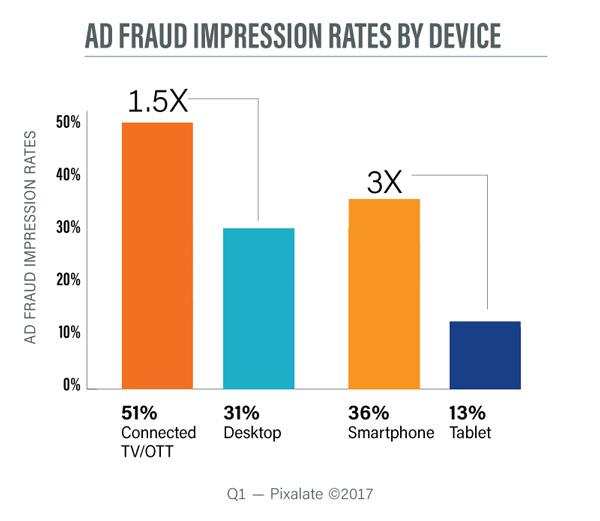According to data intelligence platform Pixalate, 51% of connected TV and over-the-top (OTT) ad impressions served
programmatically were fraudulent in Q1 2017. That number was 36% on smartphones, 31% on desktop and 13% on tablets during the same period.
“What is happening in the connected
TV/OTT space is similar to what has happened in mobile,” Jalal Nasir, CEO of Pixalate, told Real-Time Daily via email. “As in mobile, measurement in connected TV/OTT is very
difficult to do, which has made it a breeding ground for fraudsters. They have moved from desktop display to mobile and connected devices.”
Focusing on desktop, one country --
Japan -- had by far the highest rates of programmatic ad fraud in Q1. Japan’s 80%+ desktop ad fraud impression rate is more than twice as high as second-place Brazil, which was closely followed
by the United States, both with about 38% programmatic ad fraud impression rates on desktop.
“Pixalate deems all traffic originating from data center IP addresses as
deterministically invalid,” Nasir said of the rates of fraud in Japan. “Based on our Q1 2017 dataset, Japan stood out with the largest percentage of their programmatic inventory
originating from data centers... which helps explain the high ad fraud rate.”
When it came to rates of programmatic video ad fraud (across devices) by country, India topped the
list with about 34%, followed by the U.S. at around 27% and Canada at 23%. On mobile devices, Germany topped the programmatic ad fraud list -- about 44% rates of ad fraud on smartphones and tablets.
The United States took second spot again with programmatic mobile ad fraud rates in the high 30s.
Over half (56%) of programmatic video ad placements on mobile Web browsers in Q1
were considered fraudulent by Pixalate. On smartphone apps, the rate of programmatic video ad fraud was at 37%. Desktop video ad fraud rates came in at just under 25%.
Smartphone
apps saw about 36% programmatic ad fraud impression rates across the board in Q1, compared to 12% for tablet apps.
“Programmatic ad fraud remains an issue for buyers and
sellers,” concluded Nasir. “Our data insights are meant to provide a more granular look at the problem by conveying how different screens, devices, channels, and geographies can influence
the discussion.”
Pixalate admits that standards for defining fraudulent impressions are malleable and ever-changing, but says it works with industry leaders in ad-fraud
reporting to measure actual fraud rates as accurately as possible.


chart's courtesy of Pixalate © 2017